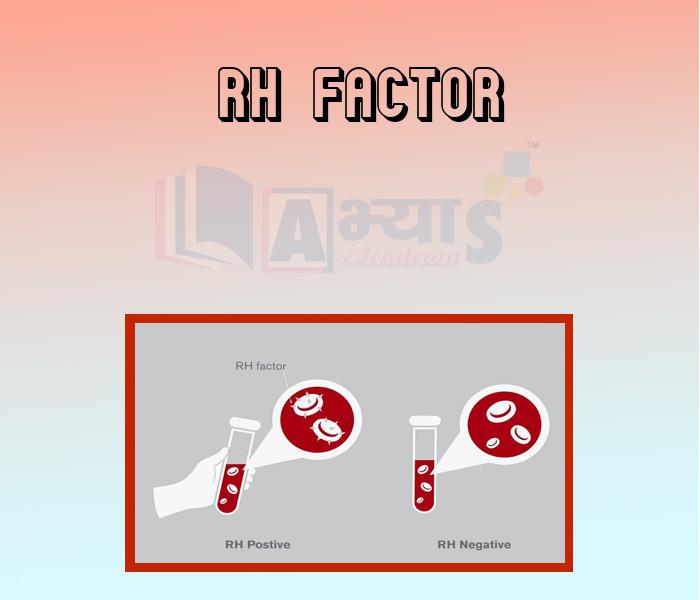Rh Factor













Rh Factor
Rh Grouping / Factor
Apart from the antigens discussed in the previous section, another antigen, known as Rh antigen (similar to the one present in Rhesus monkey) is also found on the RBCS surface in majority of humans (nearly about 80%). Individuals having Rh antigen are called Rh positive and those without the Rh antigen are called Rh negative
.
Rh group is mandatory to be matched before transfusion of blood is done. An person if gets exposed to
blood, it will form specific antibodies against the Rh antigens.
Rh Incompatibility During Pregnancy : - A special case of mismatching of Rh group or Rh incompatibility has been observed between the
blood of a pregnant mother with
blood of the foetus (the foetus of Rh woman and a
man).
In such a case, mother becomes sensitive, while carrying an baby in her womb. The reason is that some of the RBCS from the developing foetus enter into the bloodstream of the mother during development. This causes the development of anti-Rh antibodies in mother's blood.
The Rh antigens of the foetus do not get exposed to the Rh blood of the mother in case of first pregnancy (because two blood remain separated by placenta).
However, during delivery of the first child, there occurs a possibility that maternal blood may get exposed to small amounts of Rh blood from the foetus. Hence, preparing antibodies against Rh antigens in her blood. Thus, in case of her subsequent pregnancies, Rh foetuses get exposed to the anti-Rh antibodies. These antibodies will reach the blood of the foetus (Rh *) and destroy foetal RBCS.
This could be fatal to the developing foetus and could cause severe anaemia and jaundice to the developing baby. This is known as erythroblastosis foetal is or haemolytic disease of newborn.
Precautions : -
1. This condition can be avoided by administering anti-Rh antibodies to the mother immediately after the delivery of the first child.
2. Rh factor was discovered by Landsteiner and Weiner (1940) after immunising the rabbits with the blood of a monkey (Macaca rhesus).
3. There are 30 or so, known antigens on the surface of red blood çells that give rise to different blood groups, eg., MN, etc.
Students / Parents Reviews [10]
My experience with Abhyas is very good. I have learnt many things here like vedic maths and reasoning also. Teachers here first take our doubts and then there are assignments to verify our weak points.

Shivam Rana
7thMy experience with Abhyas academy is very good. I did not think that my every subject coming here will be so strong. The main thing is that the online tests had made me learn here more things.

Hiya Gupta
8thBeing a parent, I saw my daughter improvement in her studies by seeing a good result in all day to day compititive exam TMO, NSO, IEO etc and as well as studies. I have got a fruitful result from my daughter.

Prisha Gupta
8thAbhyas is a complete education Institute. Here extreme care is taken by teacher with the help of regular exam. Extra classes also conducted by the institute, if the student is weak.

Om Umang
10thIt was a good experience with Abhyas Academy. I even faced problems in starting but slowly and steadily overcomed. Especially reasoning classes helped me a lot.

Cheshta
10thIt was good as the experience because as we had come here we had been improved in a such envirnment created here.Extra is taught which is beneficial for future.

Eshan Arora
8thI have spent a wonderful time in Abhyas academy. It has made my reasoning more apt, English more stronger and Maths an interesting subject for me. It has given me a habbit of self studying

Yatharthi Sharma
10thMy experience was very good with Abhyas academy. I am studying here from 6th class and I am satisfied by its results in my life. I improved a lot here ahead of school syllabus.

Ayan Ghosh
8thAbout Abhyas metholodology the teachers are very nice and hardworking toward students.The Centre Head Mrs Anu Sethi is also a brilliant teacher.Abhyas has taught me how to overcome problems and has always taken my doubts and suppoeted me.

Shreya Shrivastava
8thAbhyas Methodology is very good. It is based on according to student and each child manages accordingly to its properly. Methodology has improved the abilities of students to shine them in future.
